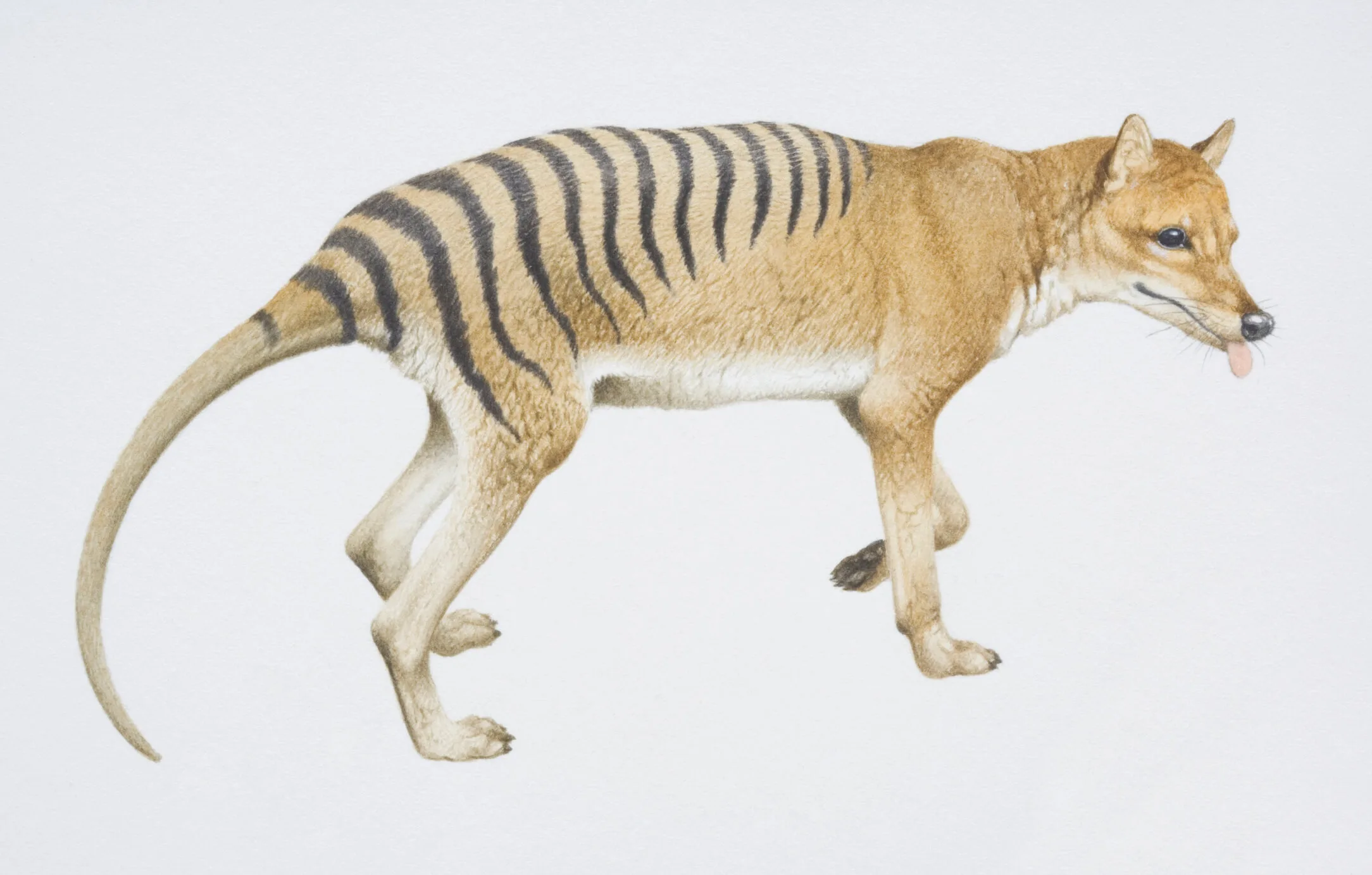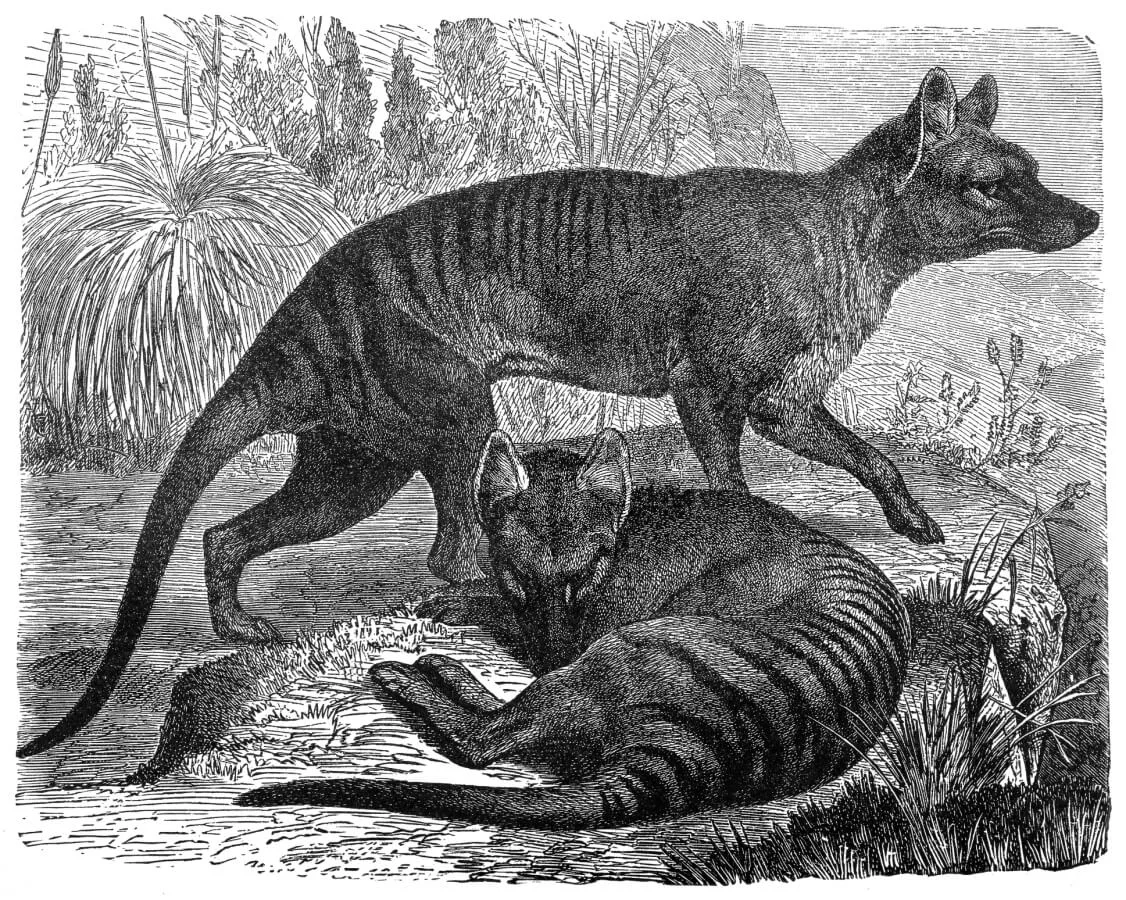The Thylacinidae family was a diverse group of approximately ten different species of dog-like, carnivorous marsupials. All of these species went extinct millions of years ago – except for the Thylacine, also known as the Tasmanian Tiger or Tasmanian Wolf, which persevered into modern times.
However, in 1936, the last known Tasmanian Tiger died, and the Thylacine was considered extinct. Nonetheless, recent Tasmanian tiger sightings have continued to persist since its apparent extinction, and these Thylacine sightings have some scientists seriously asking – do Tasmanian tigers still exist?
RELATED: 40 Funniest Wildlife Photos Ever
What did the Tasmanian Tiger look like?
Weighing approximately 25kg, the Thylacine was around 60cm tall at the shoulder, with a body roughly 115cm long and a 50-65cm long tail. The Tasmanian Tiger was a sandy brown-yellow and had dark stripes wrapped around its back. The large head had a short snout and three premolars on both jaws. This meant it strongly resembled a dog or a wolf, however, unlike canines the legs were proportionally short and the tail was stiff. As such it generally moved at a slow pace.
Like most marsupials, the female had a pouch – hence the scientific name Thylacinus Cynocephalus meaning “dog-headed pouched-dog”. Unlike most marsupials, the males also had an abdominal, back-opening pouch.

What did the Tasmanian Tiger eat?
The carnivorous Thylacine ate rodents, birds, kangaroos and other marsupials. While it was also out during the day, it was mostly nocturnal and usually hunted at night, in pairs or alone. While they were reported to prey on poultry and sheep, this behaviour is now believed to be largely exaggerated – it was also very unlikely to attack humans.
Where did the Tasmanian Tiger live?
Before colonisation, the Thylacine was not confined only to Tasmania. It could be found across the entirety of Australia, and even into the south of New Guinea. However, around 2,000 years ago, it became confined to the small island state of Tasmania, which is why it became known as the Tassie Tiger. In Tasmania, the Thylacine was most predominant along the north and east coast, and in the midland plains region.
Extinction in Tasmania
When Europeans first settled, the Tasmanian tiger was rarely seen, however, they became increasingly blamed for attacks on sheep. In an attempt to curb their population, bounty schemes began to be established, with both private companies and the Tasmanian government offering money in exchange for dead Thylacines by 1830.
In addition to these relentless attempts to control their numbers, several other factors drove the Tasmanian tiger to its eventual extinction. Australia’s colonisation also heralded the erosion of the Thylacine’s habitat, the simultaneous extinction of its prey such as the Tasmanian native hen, and the introduction of wild dogs by European settlers. Furthermore, diseases were introduced which had a significant impact on the Tasmanian tiger’s population.
By the 1920s, sightings of the Tasmanian tiger in the wild had become extremely rare and in 1930, a farmer from Mawbanna named Wilf Batty shot and killed the last known wild Tasmanian tiger.

The last Thylacine
The final captive Tasmanian tiger was caught in the Florentine Valley in 1933 and transferred to the Hobart Zoo. On September 7, 1936, the final Thylacine, which became known as “Benjamin” died in captivity. Black and white footage of Benjamin recorded in 1933 would become historically significant as the final images of the final Thylacine. Awareness for the status of the Tasmanian tiger was so low that after Benjamin died, Hobart Zoo expected they would soon receive a replacement, and the death of the last Tasmanian tiger wasn’t even reported in the media.
Are Tasmanian Tigers still alive?
Zoologist Jeremy Griffith and farmer James Malley conducted the most intensive search for the Tasmanian tiger ever between 1967 and 1973. This included comprehensive surveys along the west coast of Tasmania, investigations of sightings, installation of automatic camera stations, and the creation of an expeditionary research team. They found no evidence of the Thylacine’s existence.
However, there have been many unconfirmed encounters with Tasmanian tigers since Benjamin’s death in 1936. In 1938, a Thylacine was said to be shot at Mawbanna. In 1957, a specimen was reportedly spotted from a helicopter. In 1961, a creature killed at Sandy Cape in Queensland was identified tentatively as a Tasmanian tiger.
Thylacine hunter Michael Moss maintains that the Tas tiger may still roam the mainland, and encourages people to keep looking.
Latest Tasmanian tiger sightings
In 2005, two German tourists to Tasmania, Klaus Emmerichs and Birgit Jansen claimed to have taken pictures of a live Tasmanian tiger.
In November 2017, three investigators including Adrian Richardson, who has been hunting for the Thylacine for 26 years, captured video of what they claim is a Tasmanian tiger in Hobart. “I don’t think it’s a Thylacine … I know it’s a Thylacine,” Richardson said.
In June 2018, a Sydney man shared home surveillance footage of a creature he believed to be a Tasmanian tiger.
A Victoria farmer, Peter Groves, made the news after allegedly spotting a Thylacine while walking near Clifton Springs on January 4, 2019. Groves managed to pull out his mobile phone and snap a picture of the creature which he then uploaded to social media. “It could just be a mangy fox, but it seems to be bigger than a fox and it’s not shy,” Groves explained. “There is a lot of bush and a lot of cover and I think it’s living quite comfortably there.” He described the specimen as “funny looking … with a big long tail and stumpy ears”.
Regardless of whether the Thylacine is extinct or alive, the debate will continue to rage until definitive proof emerges.
RELATED: Five Incredible Day Trips From Hobart
 Getty
Getty









